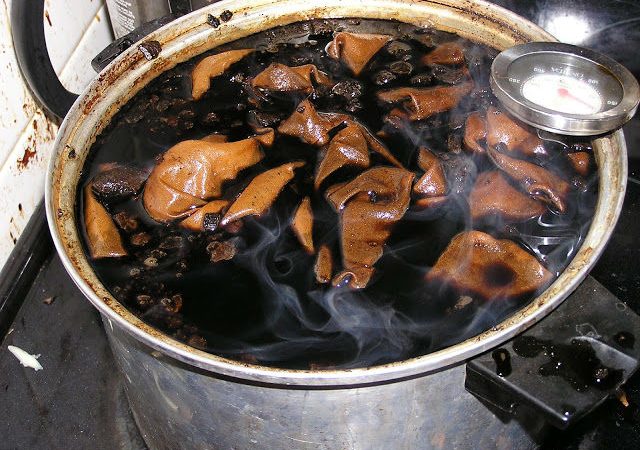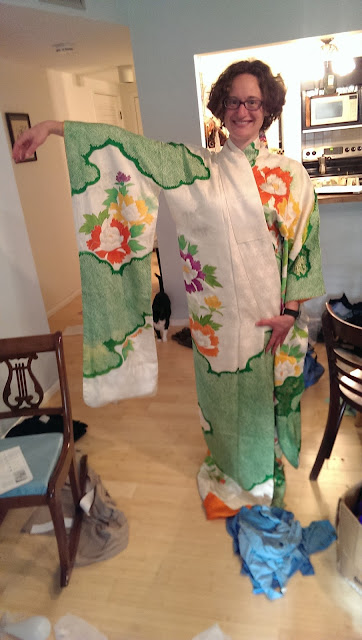I like to play around with pretty much all aspects of working with fiber and fabric. One thing that can be really fun to play with is natural dyes. There is tons you can do with synthetic dyes as well, but I have decided to restrict myself to natural dyes. Part of this is for the safety aspect, although I want to point out that natural does not always equal safe. In particular, some of the mordants that can be used with natural dyes contain heavy metals that are definitely hazardous. The only mordants that I use are cream of tartar and alum. Alum is used in canning (i.e. it is food safe) and can be purchased in the spice aisle of the grocery store.
A bit of background about this project. Last year, I bought a vintage silk kimono online.
Isn’t it gorgeous! Kimono silk is some seriously beautiful silk. This particular one has both embroidery (the flowers) and shibori (the green areas). It’s hard to tell from the picture, but each of the white dots that are in the green area were tied off by hand before being dyed. Kind of incredible. Like with the saris, used kimonos are also really cheap relative to other silks (especially taking into account their amazing designs). The kimonos are a bit more work because you have to disassemble them, but it’s not too hard because they are generally hand stitched. The other downside to kimonos is that the fabric is only about 13″ wide. But it is actually fair amount of fabric; I got a beautiful maxi dress and a skirt out of this one kimono.
Like all vintage fabric, there is always the likelihood of stains or other damage. For this particular kimono, the outer fabric was almost perfect, but the lining was badly stained. Being a person who doesn’t like to waste anything, however, I started thinking of ways to make it usable. Since the stains were brown, I decided to try dyeing the fabric brown!
 |
| Look at those stains! |
From my previous dying experience, I knew that black walnut hulls make a very nice, colorfast brown. I use
The Handbook of Natural Plant Dyes as a guide. It is very basic, but I think that it is a nice introduction to natural dyes. The first step is to mordant the fabric. With black walnut, it is not necessary to mordant, but it is supposed to give a nicer color. For the silk, you just weigh it, dissolve the cream of tartar and alum in hot water, then let it soak overnight.
 |
| Mordanting the silk |
I collected the black walnuts myself. They are native to Missouri, and I get them from a local park. The shells are incredibly hard to crack, so I actually did not use the nuts at all. I just removed the hulls and let them dry out. Before using them, I had to grind them into power.
I did not want to use my spice grinder because the hulls were not super clean, and I try to keep my dyeing separate from things I use for eating. (I have a pot used just for dyeing.) Once I started pounding, I realized it was making a lot of dust, hence the bandana. If I had thought about it before hand, I would have grabbed a mask from my lab. As it was, I definitely ended up with a bunch of brown stuff in my nose.

My awesome cast iron mortar and pestle I inherited from my grandmother. (I actually do use it for cooking, but it is easier to clean than my spice grinder.)
 |
| The walnut hulls ground into powder. |
Once the hulls were ground, I added water and brought the pot to a simmer. Then I added the silk and simmered for half an hour.
I removed the silk and let it cool a bit in the sink. I rinsed it really thoroughly to remove excess dye and bits of hull (my grinding was not perfect). Then I gave it a final wash with a bit of Eucalan and hung it to dry.
 |
| The fabric while drying. |
I am absolutely in love with the final result! If you look really closely you can pick out a couple spots where you can make out the stains, but I do not think it will be noticeable in the course of normal wear. Brown is not a color I normally gravitate to, but I think that this is a really lovely shade. I am especially pleased that I managed to turn something that was basically unusable into something that I love.


Hi Kiri,
You mention weighing the fabric and then mixing Alum with Cream of Tartar to soak it in. Can you give me the proportions of fabric weight – water – alum- Cream of tTartar? That would be so helpful.
Thanks, looking forward to hearing from you and wishing you peaceful Holidays!
Marlis
The ratio I used was 1 1/2 teaspoons each of alum and cream of tartar per 4 oz of dry weight of fabric.
Hi. Were the walnuts you collected already dried/brown, or still green and recently fallen from the tree? Thanks
The ones I used for this were dried, but you can also use fresh. Fresh will give a darker color with less material.